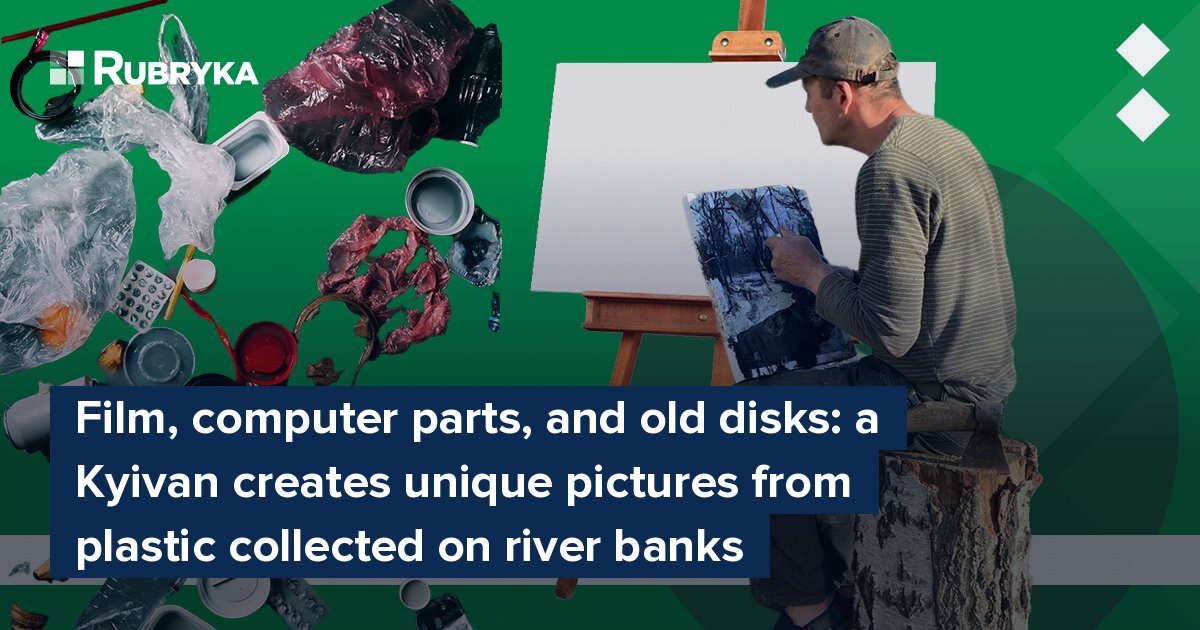
What is the problem?
River banks and reservoirs themselves are often polluted with various garbage and plastic. When going to relax in nature, people head to the water and bring food and drinks with them, along with many bags, wrappers, and bottles, but not everyone disposes of the garbage with them after rest.
What is the solution?
Dmytro Ulyanov, a 47-year-old resident of Kyiv, has been rooting for the fate of rivers for a long time. He often collected garbage on the banks of reservoirs and even organized an initiative to clean up the environment from waste with like-minded people.
"I adore Kyiv's rivers," says Ulyanov. "Back in my school years, I used to skip classes on the banks of the Lybid River. Reservoirs are like the blood of our ancestors. When you clean the banks, internal cleaning also takes place."
At first, Ulyanov simply collected garbage and threw it away. One day he saw a fire on the shore and went toward it. Amidst the heat and ash, he saw how plastic melts and what strange patterns it can form.
"I was in a creative crisis and looking for my way. I understood that there are many artists in painting, and it won't be easy to stand out among the others. There was simply not enough money for paint. When I saw how the plastic was melting, I realized this was my chance," Ulyanov recalls.

Dmytro Ulyanov, a 47-year-old resident of Kyiv, creates art pieces from plastic
How does it work?
At first, Ulyanov did not succeed in everything, but he was not used to giving up. Back in school, the drawing teacher scolded him before his relatives because the boy couldn't draw a plum. Only thanks to his godfather Kyrylo, who was engaged in icon painting, young Ulyanov learned the basics of fine art. When he started working with plastic, he did not abandon the idea but began experimenting and researching.
"The first paintings looked like scrambled eggs," the artist shares.
In the work process, many questions arose because plastic is different — it melts in different ways, and it rests on the base in different ways. It took the artist seven years to develop his own technology.

The artist uses everything he finds on rivers' banks: polyethylene film and parts from machines and computers. He creates colored and monochrome pictures. Sometimes the very shape of the part inspires a certain idea. Sometimes he leaves whole parts of plastic in the picture so that the viewer can see what it's made of — a computer keyboard or parts of disks.
Creating one picture can take 300 grams to 1 kilogram of plastic. Ulyanov says that he once made one painting in three days, but usually, it takes one to two months. He spent half a year creating pictures Sovky and Opera Theatre.
Previously, Ulyanov had a whole laboratory with tools and chemicals. However, he lost his home and workshop, as he says, due to charlatans. Now he lives in one of the villages near Kyiv, where acquaintances allowed him to live. The artist continues to create despite all the challenges, including the absence of electricity in the house.
"I made from memory the tools that were used back in the 19th century, in particular when tinning pans," says the artist, "I use them to create new paintings."

Ulyanov's paintings were exhibited in the Kyiv's Museum of Water and the Museum of Toilet History
Now plastic paintings are born in the most natural conditions. The plastic melts on the fire on which Ulyanov cooks his food. First, he fries the fish and then the plastic.
"Before, I first photographed what I wanted to depict. Now the landscape is born in the process. I am interested in what can come out of the available material. I already know how this or that type of plastic will behave, what I need to add to get what I need ", says Ulyanov.

The only printed photo from the exhibition that remained with the artist after he lost his apartment
Does it really work?
Ulyanov's paintings were exhibited in the capital's Museum of Water and the Museum of Toilet History.
The artist has paintings dedicated to the planet Mars. He says that he created them from old Mercedes parts. When the full-scale invasion began, Ulyanov was just painting one of the works dedicated to the red planet.

Pictures from plastic attract attention of visitors
The artist helped volunteers deliver humanitarian goods to Irpin in the Kyiv region when hostilities occurred there. Now he earns a living by doing repairs.
"I have to somehow survive," he says, "I'm a professional designer. I can design any interior, or I can just do high-quality repairs."
In his spare time, Ulyanov continues to create paintings. Currently, he is working on a series of paintings, Rivers of War — pictures in small A3-A4 format. The artist does not reveal the secrets of the technique, and he only says that it is a heat treatment of plastic.
These paintings can be washed simply in the bathroom; they have no smell and will live forever.
"I have seen that many people make paintings from plastic, but I have never seen such a technique," says Ulyanov.
The artist wants to sell paintings to be able to help the army. Now he and a friend are trying to revive an old environmental initiative, and they plan to register a non-governmental organization to continue cleaning the banks of rivers, attract more people to rallies, popularize knowledge about rivers among the population, and also hold auctions so that the funds received from the sale of paintings can be directed to the needs of the Ukrainian army.
Newsletter
Digest of the most interesting news: just about the main thing








